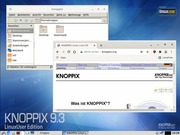Your attempt with Mint MATE did not finish properly before
What do I miss ?
(Your question was about install on EFI BIOS setted ?
I did find during install the warning - something similar saying as - "not tecommended on EFI, on own risk". Did it and worked.
Knoppix I am able to install, and install PaleMoon and XP Wordpad (into) WINE. And from stick as (the) DVD-version.
Linux Mint Mate did work to install (on EFI).
A neighbour´s laptop - since months - he is it running just for online TV, and Youtube, and some browsing the internet - all well.)
This thread (regarding setting specific partitions) is no longer really needed if you will follow the standard advice and let Linux Mint (or other Linux) set up your partitions for you instead of trying to do it yourself
Yes. OK.
(Knoppix there seems to be an exception, which did it make difficult to me, to get in touch already only to, because of two partitions required prepaired to be able to install. Yes sorry, I am realizing the (some) reasons why Knoppix is not recommended to install on HD.)
what brand/model of computer you are using
A laptop - (about from 2010) - 1,6 GHz, but all well. (Real Installed (7.6., not the Flash-(DVD-)version).)
And on PC board - about 2010, about 2,8 GHz - the stick (the Flash-version) with 9.3 all well.
(The Linux Mint Mate - the Flash AND live version (all in one) from stick - on Laptop and on PC, on first partition from two.
The bootloader for the second partition would have been another challenge, if I would continue this way. But don´t because of an other plan, just figuriing out these days.)
(RAM both (laptop, PC) 4 GB, only.)
"Help installing Linux Mint MATE on (brand & model of computer)"
I would prefer without brand and model ..., this can be added within the exchange, if somebody at all has a special trouble with a special brand or model.
´MX Linux install and Virtual Machine´ or/and ´Virtual Machine in Linux Mint Mate´.
(But both - at the same time now - currently just overhelms me.)
the Knoppix "installation tool" will only put the "live version" onto a hard drive
No, The "install to flash drive" does THIS. To HD with the choice ´To HD´ also possible, then this but as the DVD-version.
(The "installation tool" does the real installing on HD.
But requires 2 partitions already before manual prepared, with 2 different file-systems.)
Knoppix is probably not your best choice
I take this advice and I am planning now Knoppix for into VM in Linux Mint Mate. Thanks.


